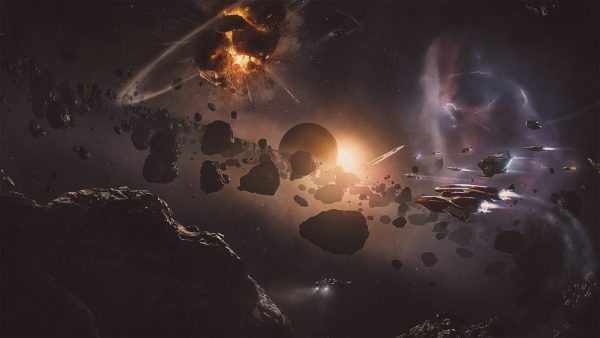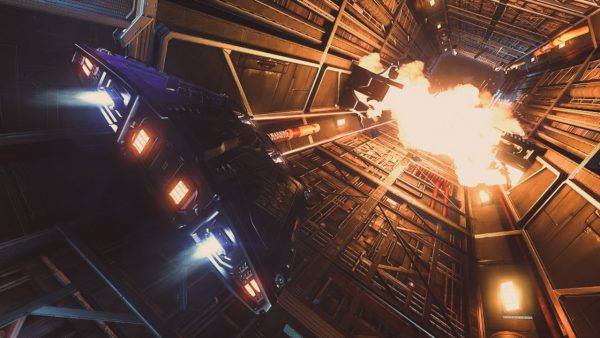
Astronomers dream of being able to voyage between the stars they observe and explore our galaxy. While it’s very unlikely that we will get to voyage the stars in our lifetime due to the vast distances involved, the computer game Elite Dangerous gives us a pretty good idea of what it might be like.
Elite Dangerous, released in December 2014, is the fourth game in the Elite series. The first version of Elite was written by David Braben and Ian Bell for the BBC Microcomputer and was released way back in 1984. For the time, it was a huge technical achievement and a milestone in computer gaming. It was followed by Frontier: Elite II on the Amiga computer in 1993, and Frontier: First Encounters in 1995, which introduced a game world based on real-world star data. David Braben has keen interests in mathematics and physics, and this is reflected in the games he helped create.
Elite Dangerous is an online multiplayer space simulation game. In the game, players (known as Commanders, or CMDR for short) start with very little money, at the controls of a Sidewinder, a small spaceship docked in a remote starport with 7.56 light-years jump range and modest cargo capacity. Players can earn money in the game running missions between space stations, either alone or teaming up with other human players, aspiring to upgrade their ship or even trade up to bigger and more capable ships. Careers open to players include trader, miner, passenger liner pilot, military, search and rescue, bounty hunter, pirate, smuggler – and explorer.

From the moment your ship travels up the elevator and departs the space dock, the feeling of scale is immense. The game creates some truly beautiful visuals of our galaxy, and the game supports virtual reality headsets. The only concession the game makes to real-world physics is the ability to exceed the speed of light and hyperspace between stars. This concession allows players to journey anywhere within our galaxy.
The centrepiece of the game is its open-world – Our own Milky Way galaxy, recreated at 1:1 scale in stunning detail with more than 400,000,000,000 stars. One only needs to use the zoom feature available on the game’s Galactic Map to get a sense of how massive our galaxy really is.
Stars of all known spectral types are represented – from blue-white stars and hypergiants to common red dwarfs, to rarer Wolf-Rayet, Carbon stars, white dwarfs, neutron stars, and even black holes (complete with gravitational lensing). Within each star system, planets of many different types and hues can be found, from barren rocky bodies to icy worlds, to Earth-like worlds and gas giants, some including complex moon and ring systems. Wherever you are in the galaxy, the backdrop of stars you see from your spaceship is correct based on your location. From the starting location, Barnard’s Loop and Witch Head nebula are clearly visible.

The Large and Small Magellanic clouds, M31 Andromeda Galaxy, Messier 110 and the Triangulum Galaxy are present in the distance. The in-game galaxy features approximately 150,000 real stars in their correct position, taken from available sky catalogue data (Such as Luyten, Hipparcos, Bonner Durchmusterung, Harvard Revised Photometry Catalogue). In addition, there are dozens of spectacular nebulae of varting types (taken from the New General Catalogue) recreated in #D, including reflection, supernova, planetary and dark.
Of course, our Solar System “Sol” is recreated faithfully, with all planets presents in the correct positions (for the year 3304), as well as many planetoid and major moons. From our Solar System, the band of the Milky Way is bright in the sky, and familiar constellations are instantly recognisable. Mars has been terraformed, and the great canyon Valles Marineris is visible as an enormous ocean. On Europa, geothermal geysers shoot ice skywards.
As a kind of an Easter egg, the “ancient” Voyager 1 and 2 space probes can be found by keen explorers in the positions they will be in by 3304. Locating these probes can be done by careful alignment of our Sun against specific real background stars. From the comfort of their own home, Commanders could recreate their own version of famous images, such as the Blue Marble, Earthrise and the Pale Blue Dot.

For areas of the galaxy outside our catalogue of know stars, a computer algorithm called “Stellar Forge” procedurally generates star systems using the current scientific understanding of stellar formation. Stellar Forge uses “available mass” for the regions of space from which to generate stars and planetary systems The location of generated stars, and the orbits of bodies in star systems are determined by physics.
How accurate is the galaxy that this system creates? As it turns out, eerily accurate.
Trappist-1 is a very faint red dwarf (spectral type M8) 39.6 light-years from Earth. So faint in fact that it does not appear in most star catalogues, and so was not originally included in the game. When 7 planets were discovered orbiting Trappist-1 in 2015, it was found that the Elite Stellar Forge algorithm had already determined through the unaccounted mass that a star should be there, and created a brown dwarf star within 1ly of the real Trappist-1 location. Not only that, it had 7 terrestrial planets, just like the real Trappist-1. It only required a small tweak, and Trappist-1 was depicted accurately within the game.

In 2016, astronomers announced the discovery of Proxima Centauri B, a possible earth-like world in orbit around Proxima Centauri. Proxima Centauri in Elite Dangerous already had a planet orbiting it – Eden. In the lore of the game, the possibility that Eden was Earth-like and the confirmation in the early 21st century of the presence of water on Eden made it the destination of the first interstellar voyage. However, on reaching Eden, it turned out to be far from paradise. Instead of blue marble, explorers found an inhospitable metallic body with a water atmosphere, irradiated by the nearby star. Players of Elite Dangerous lobbied to have the real planet officially named Eden.
Explorers are free to travel wherever they like in the galaxy. A player might choose to take a trip to Maia in Pleiades Nebula. Or, one could take a trip out to the double star Albireo in Beta Cygni – 433.8 light-years from Sol – to see how far apart these stars actually are. You can visit the supergiants Betelgeuse and VY Canis Majoris. You can even voyage 25,900 light-years to the galactic core and stare into the abyss of intense gravitational lensing of Sagittarius A*, the supermassive black hole at the centre of our galaxy.

You could take a tour of the many nebulae in our galaxy. Such a trip could start at the Witch Head Nebula, then outwards to the Orion Nebula (there is a visitor’s centre there), Barnard’s Loop and Horsehead Nebula, then keep going across the Orio-Persan gap between Orion Spur and Perseus Arm, 5000 light-years out to Jellyfish Nebula.
The galaxy represented within the game is so rich, it has inspired Commanders to band together into official expeditions. There is a player community effort to map the Elite galaxy, and record discoveries in the Elite Dangerous Star Map website (edsm.net). These explorers have set distance records attempting to visit stars most distant from Sol. Early explorers struggled to reach Beagle Point (65,279 light-years), but after newer more capable exploration ships were introduced, and after technology improvements within the game, commanders have been able to reach even more distant worlds.

Semotus Beacon (Ishum’s Reach) (65,647.34 light-years) is now the most distant accessible star, and Salomé’s Reach, the outermost moon of the secondary star, is officially the most distant point from Sol in the galaxy. Players who are the first to visit stars and planets in the game have their Commander name forever recorded on them as the first discoverer.
And yet, with all the concerted efforts of Elite commanders, to date players have explored only 0.04% of the galaxy. Perhaps one day, I will see you out in the black, Commanders. o7 CMDR HunterZero.
Elite Dangerous is available on PC, Xbox One and PS4.





